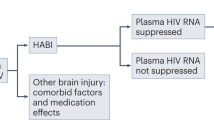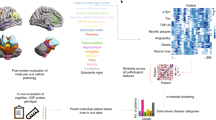Key Points
-
The fifth edition of the Diagnostic and Statistical Manual of Mental Disorders (DSM-5) provides a framework for the diagnosis of neurocognitive disorders based on three syndromes: delirium, mild neurocognitive disorder and major neurocognitive disorder
-
Major neurocognitive disorder is mostly synonymous with dementia, although the criteria have been modified so that impairments in learning and memory are not necessary for diagnosis
-
DSM-5 describes criteria to delineate specific aetiological subtypes of mild and major neurocognitive disorder
-
The diagnostic certainty of an aetiological diagnosis is based on clinical features and biomarkers, and can be qualified as probable or possible
-
The DSM-5 criteria are consistent with those developed by various expert groups for the different aetiological subtypes of neurocognitive disorders
-
Further validation in clinical practice is necessary, but we expect these criteria will have high reliability and validity, and widespread adoption will bring consistency to the diagnosis of diverse neurocognitive disorders
Abstract
Neurocognitive disorders—including delirium, mild cognitive impairment and dementia—are characterized by decline from a previously attained level of cognitive functioning. These disorders have diverse clinical characteristics and aetiologies, with Alzheimer disease, cerebrovascular disease, Lewy body disease, frontotemporal degeneration, traumatic brain injury, infections, and alcohol abuse representing common causes. This diversity is reflected by the variety of approaches to classifying these disorders, with separate groups determining criteria for each disorder on the basis of aetiology. As a result, there is now an array of terms to describe cognitive syndromes, various definitions for the same syndrome, and often multiple criteria to determine a specific aetiology. The fifth edition of the Diagnostic and Statistical Manual of Mental Disorders (DSM-5) provides a common framework for the diagnosis of neurocognitive disorders, first by describing the main cognitive syndromes, and then defining criteria to delineate specific aetiological subtypes of mild and major neurocognitive disorders. The DSM-5 approach builds on the expectation that clinicians and research groups will welcome a common language to deal with the neurocognitive disorders. As the use of these criteria becomes more widespread, a common international classification for these disorders could emerge for the first time, thus promoting efficient communication among clinicians and researchers.
This is a preview of subscription content, access via your institution
Access options
Subscribe to this journal
Receive 12 print issues and online access
$209.00 per year
only $17.42 per issue
Buy this article
- Purchase on Springer Link
- Instant access to full article PDF
Prices may be subject to local taxes which are calculated during checkout


Similar content being viewed by others
References
American Psychiatric Association. Diagnostic and Statistical Manual of Mental Disorders 1st edn (American Psychiatric Association, 1952).
American Psychiatric Association. Diagnostic and Statistical Manual of Mental Disorders 4th edn (American Psychiatric Association, 1994).
Prince, M. et al. The global prevalence of dementia: a systematic review and metaanalysis. Alzheimers Dement. 9, 63–75 (2013).
American Psychiatric Association. Diagnostic and Statistical Manual of Mental Disorders 5th edn (American Psychiatric Association, 2013).
Ganguli, M. et al. Classification of neurocognitive disorders in DSM-5: a work in progress. Am. J. Geriatr. Psychiatry 19, 205–210 (2011).
Sachdev, P. S. Is DSM-5 defensible? Aust. N. Z. J. Psychiatry 47, 10–11 (2013).
Sternberg, R. J. & Sternberg, K. Cognitive Psychology 6th edn (Cengage Learning, 2009).
Sachdev, P., Andrews, G., Hobbs, M. J., Sunderland, M. & Anderson, T. M. Neurocognitive disorders: cluster 1 of the proposed meta-structure for DSM-V and ICD-11. Psychol. Med. 39, 2001–2012 (2009).
Mesulam, M.-M. (Ed.). Principles of Behavioral and Cognitive Neurology 2nd edn (Oxford University Press, 2000).
Lezak, M. D., Howieson, D. B. & Loring, D. W. Neuropsychological Assessment 4th edn (Oxford University Press, 2004).
Joshi, A. et al. “What's in a name?” Delirium by any other name would be as deadly. A review of the nature of delirium consultations. J. Psychiatr. Pract. 18, 413–418 (2012).
Petersen, R. et al. Mild cognitive impairment: ten years later. Arch. Neurology 66, 1447–1455 (2009).
Sachdev, P. Is it time to retire the term “dementia”? J. Neuropsychiatry Clin. Neurosci. 12, 276–279 (2000).
Looi, J. C. & Sachdev, P. S. Differentiation of vascular dementia from AD on neuropsychological tests. Neurology 53, 670–678 (1999).
Josephs, K. A. Frontotemporal dementia and related disorders: deciphering the enigma. Ann. Neurol. 64, 4–14 (2008).
Blazer, D. Neurocognitive disorders in DSM-5. Am. J. Psychiatry 170, 585–587 (2013).
Petersen, R. C. et al. Mild cognitive impairment: clinical characterization and outcome. Arch. Neurol. 56, 303–308 (1999).
Winblad, B. et al. Mild cognitive impairment: beyond controversies, towards a consensus: report of the International Working Group on Mild Cognitive Impairment. J. Intern. Med. 256, 240–246 (2004).
Petersen, R. C. Mild cognitive impairment as a diagnostic entity. J. Intern. Med. 256, 183–194 (2004).
Albert, M. S. et al. The diagnosis of mild cognitive impairment due to Alzheimer's disease: recommendations from the National Institute on Aging–Alzheimer's Association workgroups on diagnostic guidelines for Alzheimer's disease. Alzheimers Dement. 7, 270–279 (2011).
Ganguli, M. Can the DSM-5 framework enhance the diagnosis of MCI? Neurology 81, 2045–2050 (2013).
Rabins, P. V. & Lyketsos, C. G. A commentary on the proposed DSM revision regarding the classification of cognitive disorders. Am. J. Geriatr. Psychiatry 19, 201–204 (2011).
Dubois, B. et al. Research criteria for the diagnosis of Alzheimer's disease: revising the NINCDS–ADRDA criteria. Lancet Neurol. 6, 734–746 (2007).
McKhann, G. Clinical diagnosis of Alzheimer's disease: report of the NINCDS–ADRDA Work Group under the auspices of Department of Health and Human Services Task Force on Alzheimer's Disease. Neurology 34, 939–944 (1984).
Román, G. C. et al. Vascular dementia: diagnostic criteria for research studies. Report of the NINDS–AIREN International Workshop. Neurology 43, 250–260 (1993).
Hughes, T. F., Snitz, B. E. & Ganguli, M. Should mild cognitive impairment be subtyped? Curr. Opin. Psychiatry 24, 237–242 (2011).
McKhann, G. M. et al. The diagnosis of dementia due to Alzheimer's disease: recommendations from the National Institute on Aging–Alzheimer's Association workgroups on diagnostic guidelines for Alzheimer's disease. Alzheimers Dement. 7, 263–269 (2011).
Gorno-Tempini, M. L. et al. Classification of primary progressive aphasia and its variants. Neurology 76, 1006–1014 (2011).
Rascovsky, K. et al. Sensitivity of revised diagnostic criteria for the behavioural variant of frontotemporal dementia. Brain 134, 2456–2477 (2011).
McKeith, I. G. et al. Diagnosis and management of dementia with Lewy bodies: third report of the DLB Consortium. Neurology 65, 1863–1872 (2005).
Sachdev, P. S. et al. Diagnostic criteria for vascular cognitive disorder: a VASCOG statement. Alzheimer Dis. Assoc. Disord. 28, 208–218 (2014).
Emre, M. et al. Clinical diagnostic criteria for dementia associated with Parkinson's disease. Mov. Disord. 22, 1689–1707 (2007).
Antinori, A. et al. Updated research nosology for HIV-associated neurocognitive disorders. Neurology 69, 1789–1799 (2007).
Gorelick, P. B. et al. Vascular contributions to cognitive impairment and dementia: a statement for healthcare professionals from the American Heart Association/American Stroke Association. Stroke 42, 2672–2713 (2011).
Acknowledgements
The authors would like to thank Prof. Igor Grant, the members of the DSM-5 Task Force and the other Work Groups, as well as many external advisers and consultants who provided invaluable input to the development of the classification. M.G. was supported in part by the National Institute on Aging, the National Institutes of Health, and the Department of Health and Human Services, USA (grant K07 AG044395). D.V.J. was supported in part by the National Institute of Mental Health, USA (grant R01 MH099987), and by the Sam and Rose Stein Institute for Research on Aging. P.S. was supported in part by the National Health and Medical Research Council of Australia (grant 568969).
Author information
Authors and Affiliations
Contributions
All authors researched data for the article and made substantial contributions to discussion of the content, writing of the article and to review and/or editing of the manuscript before submission.
Corresponding author
Ethics declarations
Competing interests
The authors were members of the Neurocognitive Disorders Work Group for DSM-5. D.V.J. was President of the American Psychiatric Association from 2012–2013 when DSM-5 was published.
PowerPoint slides
Rights and permissions
About this article
Cite this article
Sachdev, P., Blacker, D., Blazer, D. et al. Classifying neurocognitive disorders: the DSM-5 approach. Nat Rev Neurol 10, 634–642 (2014). https://doi.org/10.1038/nrneurol.2014.181
Published:
Issue Date:
DOI: https://doi.org/10.1038/nrneurol.2014.181
This article is cited by
-
The fusion of multi-omics profile and multimodal EEG data contributes to the personalized diagnostic strategy for neurocognitive disorders
Microbiome (2024)
-
Pattern of cognitive impairment among community-dwelling elderly in Egypt and its relation to socioeconomic status
Journal of the Egyptian Public Health Association (2024)
-
The Association Between Neurocognitive Disorders and Gustatory Dysfunction: A Systematic Review and Meta-Analysis
Neuropsychology Review (2024)
-
Associations between olfactory dysfunction and cognition: a scoping review
Journal of Neurology (2024)
-
Inhibitory Control in Gambling Disorder, Internet Gaming Disorder, and Compulsive Sexual Behavior Disorder/Problematic Pornography Use: a Review of the Last 5 Years
Current Behavioral Neuroscience Reports (2024)



